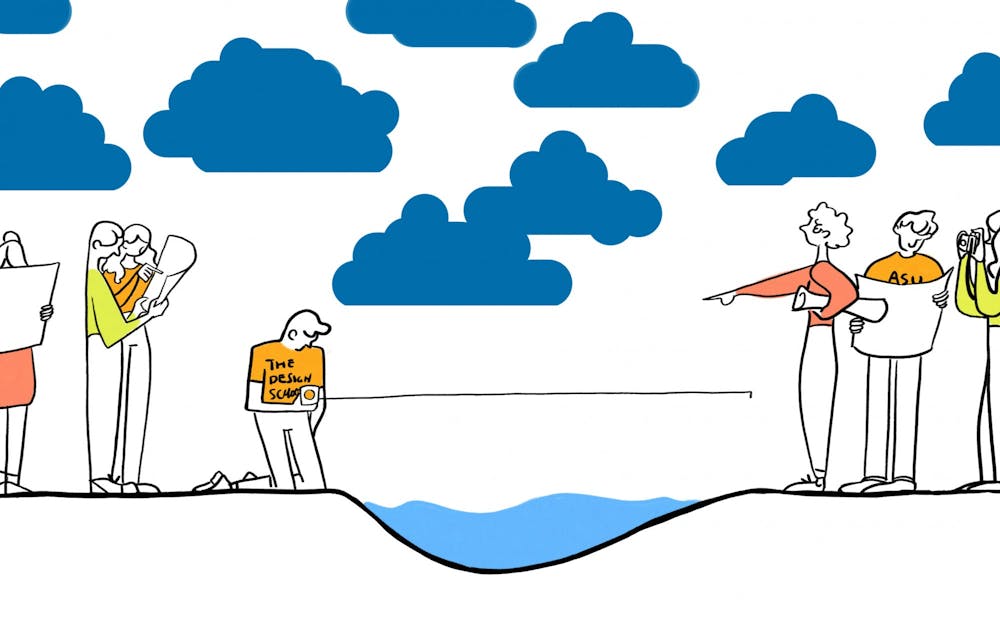An ASU research team is working together with Maricopa County to limit the negative effects large quantities of stormwater have on the environment.
Efforts at ASU's Orange Mall have already been noticed, with the project achieving silver level certification through the U.S. Green Building Council Sustainable SITES Initiative.
This is just the second project in Arizona to be certified and a first for ASU, said Chingwen Cheng, primary investigator and ASU assistant professor, in an emailed statement.
The USGBC awards these certifications on account of "protecting natural habitat, keeping open spaces, dealing with rainwater, and heat island and light pollution reduction."
The team is called the Hydro Green Infrastructure Lab and consists of faculty from The Design School working together with the Flood Control District of Maricopa County.
ASU currently has three large-scale water harvesting basins, located at Tempe’s Orange Mall, downtown Phoenix’s Taylor Mall and throughout most of the Polytechnic campus, according to co-investigator and ASU assistant professor Paul Coseo.
The main goal of the Hydro Green Infrastructure Lab is to monitor the basins and determine how efficient they are at absorbing and maintaining reasonable quantities of water going to the Salt River and other water sources.
When stormwater is not managed properly it runs through pipes and gutters in large quantities, collecting garbage on its way to dumping into water sources like the Salt River, said Coseo.
“When the water goes into the landscape first, it's able to be filtered through the soil used by the plants in the location and then when it moves through, when it goes down into the soil into the groundwater, it moves slowly towards the Salt River instead of quickly,” said Coseo.
The onset of climate change has prompted further research in ways that do not require excessive funding, Cheng said.
“Under the climate change impact, there is this uncertainty of more extreme and intense weather conditions that will happen more frequently,” said Cheng.
Coseo believes that the Phoenix metropolitan area is behind other major cities, noting that Portland has a particularly great stormwater management system.
A major disadvantage for gathering data is the sparse amount of rain every year in this arid and dry desert environment, but it doesn’t slow the efforts of the Hydro-GI Lab.
“I think the GI Lab is really focused on the performance of these because we want to be able to see if they're working, when they're working, how they're working and how we can improve them if they aren't working in the way that we want,” said Coseo.
The success of the water harvesting basins also relies on the efficiency at which plants and soil can absorb the water without being overwhelmed.
Currently at the FCDMC, soil and plant efficiency is being tested in nine identical basins where water is dumped into each and data is collected to determine which strategies are best to implement, said Rob Hussey, associate landscape designer at the FCDMC.
“The next logical step is actually for research to take place in a landscape retrofit, actually at the Flood Control District property,” said Hussey.
There is great interest throughout the county in the data collected from the Hydro-GI Lab, including Phoenix, Tempe and Scottsdale, said Cheng.
“For the interest of the county, they also want to get more current and long term data and more evidence in order to justify how they can use alternative practices,” said Cheng.
Every month cities around the county and other stakeholders interested in the data collected get together to exchange ideas, said Cheng.
In January 2019 a handbook detailing green infrastructure around stormwater management was published with help from ASU.
The Hydro-GI Lab depends a lot on collaboration within the county to efficiently collect data and exchange ideas to enhance stormwater management.
The Hydro-GI Lab's goal is to better understand the benefits of green infrastructure in order to benefit both ASU and the Phoenix Valley, said Coseo.
Reach the reporter at baharr21@asu.edu or follow @brady_harris2 on Twitter.
Like The State Press on Facebook and follow @statepress on Twitter.




